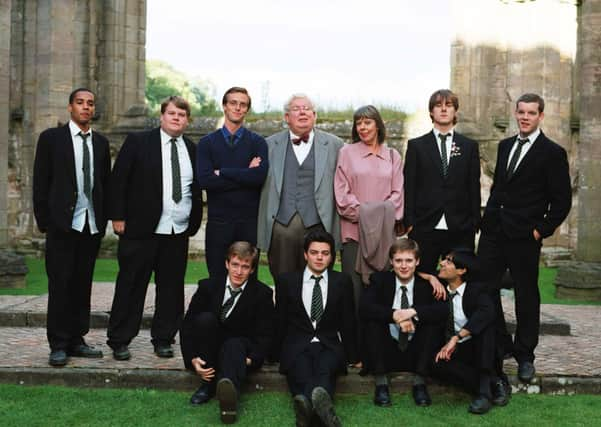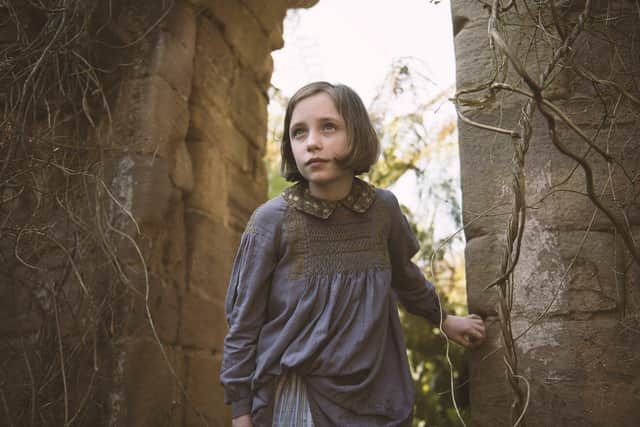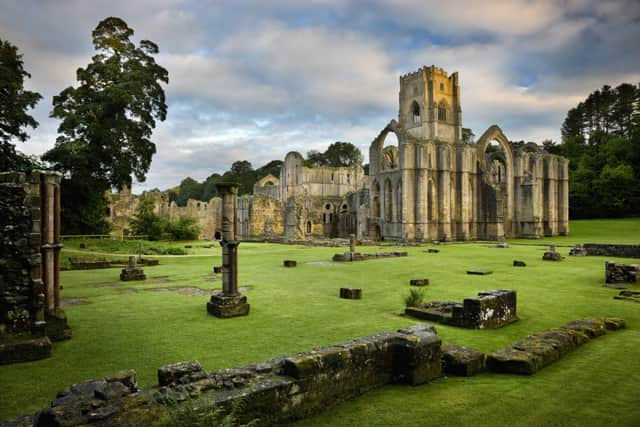Secrets of top National Trust TV and film shoots revealed
This article contains affiliate links. We may earn a small commission on items purchased through this article, but that does not affect our editorial judgement.


Ever since Colin Firth famously dived into the lake outside a stately home during his starring role as Mr Darcy in the BBC’s 1995 adaptation of Pride and Prejudice, there has been a close correlation between many of the nation’s most-loved television programmes and films and the involvement of the National Trust.
In recent years, the likes of Harry Potter, Game of Thrones and Wolf Hall to name just a few have used Trust properties as a setting for their stories – with productions tending to result in vast increases in visitor numbers whenever the finished product hits the screen.
Advertisement
Hide AdAdvertisement
Hide AdBut as a new book National Trust on Screen makes clear, such an association has not happened by accident. The book has been written by Trust employees Harvey Edgington and Lauren Taylor, two of the people whose job it is to facilitate such shoots – covering everything from “careful toad-watching” for Poldark to arranging for the safe overnight burning of a film-set village for Snow White and The Huntsman.


Edgington became involved in the world of film by chance, when he was working in the marketing department of Greenwich Council in London in the early 1990s.
At the time, Martin and Gary Kemp were filming The Krays in Greenwich but the production team was struggling to get hold of anyone at the local authority to assist.
“They were having problems with filming on the street and lots of people were upset,” Edgington recalls. “No one at the council would take it on because it wasn’t something like council housing or a highways issue. So it was left to me, I was in the marketing department at the time.
Advertisement
Hide AdAdvertisement
Hide Ad“I was sent to sort it out. I met the location manager and he was saying he had been trying to sort this out but was getting passed from department to department. I thought, let’s have just one person who can deal with these issues as a point of contact.”


He developed a brochure to send out to film companies interested in filming in London about what could be arranged in Greenwich and was soon inundated with requests.
“None of the other London boroughs did anything like that at the time and now they all do. The phone just started ringing off the hook.”
Among those to start filming in the area was Harrison Ford for his 1992 film Patriot Games and Bob Hoskins for The Secret Agent.
Advertisement
Hide AdAdvertisement
Hide Ad“I would go and do a recce with the film crew of where they wanted to go and find out what they wanted to do. Whatever council department was required - housing, environmental health and sometimes the private sector as well - I would help with. Within three months it was my full-time job.”
After Greenwich, an organisation called Film London was set up and he ended up working for them before the National Trust came calling. In 2003, he set up the National Trust Filming and Locations Office, a department he has headed up ever since.
He says despite the success of Pride and Prejudice a few years earlier (the famous lake scene was filmed at Lyme Park in Cheshire and other Trust locations were also used for the series), there was little formal structure in place before the specialist office was set up.
“The main problem was that it was too ad-hoc and there were too many different ways in. Pride and Prejudice did wake up a few people because the visitor numbers went through the roof. We had done some filming but not a lot.
Advertisement
Hide AdAdvertisement
Hide Ad“To begin with it was just me. I had a lot of relationships with location managers by then and I could say we are open for business.
“We probably do three to four TV dramas or feature films a month if not more. It has grown a lot. Because Amazon and Netflix have come along and upped the game in terms of quality, the BBC and ITV have had to compete and they can do that with TV drama. It has been a boom time.”
He says the book, timed to coincide with the Trust’s 125th anniversary, sets out to tell some the fascinating behind-the-scenes stories that people tend to be fascinated by.
Among the tales in the book is that of the extensive attempts to ensure toads key to the plot of the third series of Poldark filmed at Great Chalfield Manor in Wiltshire behaved themselves.
Advertisement
Hide AdAdvertisement
Hide AdAfter some suitable toads more likely to behave in the way wanted for the script than their native counterparts were sourced from Japan by the location manager, the Trust was concerned that they may carry disease.
“The Trust ecologist came up with a few parameters: each toad should be screened for disease, not enter the water and not mingle with native toads. Cue some very careful toad-watching,” the book explains.
It also includes one of the most memorable shoots Edgington has been involved in – that for Snow White and the Huntsman at Frensham Little Pond in Surrey.
After two-and-a-half months of building a fake village, a fire was created by laying the set with pipes so it worked “like a massive gas hob”. It was timed so that every building appeared to be on fire while stuntmen fought each other. The 500-strong crew for the shoot unsurprisingly included a real fire brigade.
Advertisement
Hide AdAdvertisement
Hide AdEdgington says it is often thrilling to see the finished production you have contributed towards.
“It is exciting and the sense of achievement you get when you do something like burn down a village is quite impressive. If you are lucky enough to see the actors at work, it can be a bit of a free show.
“Sometimes it can be disappointing if you are edited down to 10 seconds after four weeks of hard work and pain but that is how it works.”
He says the most popular films and television programme come with additional security challenges.
Advertisement
Hide AdAdvertisement
Hide Ad“With Harry Potter the security was really, really tight partly because they were children. They had a security man at Lacock Abbey in Wiltshire whose job was to look all day through binoculars at a man who was fishing down the river just to make sure he wasn’t paparazzi.”
Edgington says his job has put him in some unusual situations, including discussing the life of Beatrix Potter with Renée Zellweger when she was filming Miss Potter in the Lake District.
“It is part of the job seeing famous faces but it can be fairly strange sometimes. I just kept thinking, ‘I hope I am telling her the right information’.”
The book includes a section on Fountains Abbey in North Yorkshire, which famously starred as “itself” in a 2006 film of The History Boys which featured James Corden, Russell Tovey and Dominic Cooper and was written by proud Yorkshireman Alan Bennett.
Advertisement
Hide AdAdvertisement
Hide AdThe book also provides a sneak preview of a new adaptation of The Secret Garden, which is due for release this year and stars Colin Firth and Julie Walters. The book reveals that part of the secret garden of the title is at Fountains Abbey.
Another part of the book looks at Hardwick Hall in North Derbyshire, which was used for Harry Potter and the Deathly Hallows: Part 1 as Voldemort’s lair and as a stand-in for Hampton Court Palace for the 2019 film Mary Queen of Scots which starred Saoirse Ronan and Margot Robbie.
Edgington says that in the last decade, there has been a shift away from film crews focusing on locations in and around London, to the benefit of many Trust properties and the areas in which they are based.
“The first benefit of allowing filming is the money, which is always helpful. That goes backs to the property where the filming is happening and they tend to spend most of it on conservation.
Advertisement
Hide AdAdvertisement
Hide Ad“The second benefit is the extra visitors it brings. Game of Thrones was fantastic for us in Northern Ireland. Also a film crew will come to an area and spend a lot of money. A decent-sized crew could be spending £40,000 per night on hotels. It obviously helps local economies and everyone wins.”
No guns or nudity - without permission
Harvey Edgington says reports that the National Trust operates a ‘no nudity’ clause for filming is “not quite right”.
The detail was included in a recent Sunday Times article but Edgington says the reality is slightly different.
“There are clauses in the contract which say no nudity, no animals, no special effects and no guns but there are just to really ensure that if a production company is wanting to do those things, we know and are prepared.
Advertisement
Hide AdAdvertisement
Hide Ad“If they say there is a scene where the characters are skinny-dipping, we will say try and do it the first thing in the morning and try and take these precautions. But if they have not told us about that and we have agreed to it, that would be a breach of contract.”
National Trust on Screen by Harvey Edgington and Lauren Taylor is out now, priced £9.99. To buy visit www.pavilionbooks.com/book/national-trust-on-screen or https://shop.nationaltrust.org.uk/national-trust-on-screen.html